Study on the Typological Chronology of Cantonese Palatial-Type (Diantang Shi) Timber Structures in Guangdong Province, China: An Interdisciplinary Approach of Building Archaeology
Abstract
1. Introduction
2. Literature Review
2.1. Development of Typological Chronology and Building Archaeology in Europe
2.2. Adaptation of the Typological–Chronological Method to Ancient Chinese Timber Structure Research and the Development of Building Archaeology in China
2.3. Typological Chronology Research into Timber Structures in Guangdong Province
3. Materials and Methods
3.1. Materials
3.2. Methods
3.2.1. On-Site Investigation
3.2.2. Original Components Analysis
3.2.3. Written Sources Examination
3.2.4. Systematic Establishment of the Typological–Chronological Sequence of Structural Elements
3.2.5. Evolution Periodization by Synthesis of Typological–Chronological Sequences
3.2.6. Socio-Cultural Analysis of Evolutionary Discontinuities
4. Results
- Out of 47 existing cases, 20 Cantonese palatial-type timber structures are identified, providing dating coordinates vital for the establishment of typological chronology.
- Three bracket set elements and nine column–beam framework elements are drawn from 20 dated cases as rapidly-evolving indicators to establish typological–chronological sequences of Cantonese palatial-type timber structures.
- Based on typological–chronological sequences, three principal evolutionary phases are discerned, each comprising two internal development stages.
4.1. Dated Cantonese Palatial-Type Timber Structures
4.1.1. Twenty Dated Cantonese Palatial-Type Timber Structures
4.1.2. Case Study of Dacheng Hall of the Confucian Temple in Xinhui, Jiangmen: Two Construction Phases
4.2. System of Indicator Structural Elements
4.2.1. Three Indicator Elements of the Bracket Set
- Arrangement of Intercolumnar Bracket Sets (pingshenke) on Front Façade
- Order of Bracket Arms (gong) and Joists (fang) on the Façade Axis (zhengxinfeng)
- Relationship between Purlin (zhengxinheng) and Joist (zhengxinfang) on the Façade Axis
4.2.2. Nine Indicator Elements of Column–Beam Framework
- Main Structural Type between Innermost Columns (jinzhu)
- Style of Short Column (guazhu) in Short-Column-Beam System
- Section (liangshen) of Inserted Beam in Short-Column-Beam System
- End (liangtou) of Inserted Beam in Short-Column-Beam System
- Style of Innermost Column (jinzhu)
- Relationship between Innermost Column, Beam and Purlin
- Application of Straight Beam (zhiliang) in Strut–Beam System
- Application of Bending Tie-Beam (shuishu)
- Style of Bending Tie-Beam (shuishu)
4.3. Periodization of Cantonese Palatial-Type Timber Structures
- First Phase: Xuande Reign to mid-Wanli Reign (ca.1430–early 17th century), with an initial stage of ca.1430–ca.1490 and a terminal stage of ca.1490–early 17th century, the latter representing the mature phase of Cantonese palatial-type timber construction.
- Second Phase: mid-Wanli Reign to mid-Kangxi Reign (early 17th century–ca.1690) as the revolutionary phase of Cantonese palatial-type timber construction, with an initial stage of early 17th century–ca.1650 and a terminal stage of ca.1650–ca.1690, representing innovative phases of the short-column-beam system (chaliang shi) and strut–beam system (tailiang shi), respectively.
- Third Phase: mid-Kangxi Reign to the end of the Qing dynasty (ca.1690–early 20th century) as the final standardization phase, with an initial stage of ca.1690–late 18th century and a terminal stage of late 18th century–early 20th century.
4.3.1. First Phase: Xuande Reign to Mid-Wanli Reign (ca. 1430–Early 17th Century)
- Initial Stage: Xuande Reign to Chenghua Reign (ca.1430–ca.1490)
- Terminal Stage: Hongzhi Reign to Mid-Wanli Reign (ca.1490–early 17th century)
4.3.2. Second Phase: Mid-Wanli Reign to Mid-Kangxi Reign (Early 17th Century–ca.1690)
- Initial Stage: Mid-Wanli Reign to Mid-Shunzhi Reign (early 17th century–ca.1650)
- Terminal Stage: Mid-Shunzhi Reign to Mid-Kangxi Reign (ca.1650–ca.1690)
4.3.3. Third Phase: Mid-Kangxi Reign to End of the Qing Dynasty (ca.1690–Early 20th Century)
- Initial Stage: Mid-Kangxi Reign to Late-Qianlong Reign (ca.1690–late 18th century)
- Terminal Stage: Late Qianlong Reign to End of the Qing Dynasty (late 18th century–early 20th century)
5. Discussion
5.1. Assumption of the Cultural Origin of Short-Column-Beam System Transformation in Late Ming Dynasty
5.2. Analysis of the Political Intervention of Strut–Beam System Transformation in Early Qing Dynasty
5.3. Future Research Directions
- Comparative Study between Palatial-Type and Hall-Type Typological Chronologies within the Cantonese Architectural Tradition
- Typological–Chronological Study of Hakka Timber Constructions in Northern Guangdong Province
- Socio-Cultural Study on the Impetus for Three Evolutionary Phases of Cantonese Palatial-Type Timber Structures
5.4. Limitations
6. Conclusions
Funding
Data Availability Statement
Conflicts of Interest
References
- Xu, Y. Reconsideration of the Production Date of Ying Zao Fa Shi (Treatise on Architectural Methods) by Li Mingzhong of the Northern Song Dynasty. Palace Mus. J. 2017, 194, 6–14. [Google Scholar] [CrossRef]
- Guo, Q. Yingzao Fashi: Twelfth-Century Chinese Building Manual. Archit. Hist. 1998, 41, 1–13. [Google Scholar] [CrossRef]
- Xu, Y. Temple Architecture of the Five Dynasties to Jin Dynasty in Changzhi and Jincheng Region, Shanxi. Ph.D. Thesis, Peking University, Beijing, China, 2003. [Google Scholar]
- Zhou, M. Architectural Transformation of the Tang and Song Dynasties: Research on Wooden Structure Buildings in the Central Region of Shanxi Province, Mid-10th Century to Early-12th Century, 1st ed.; Southeast University Press: Nanjing, China, 2020; ISBN 9787564188856. [Google Scholar]
- Fu, X. Imperial Architecture of Tang through Ming and Its Relation to Other Architecture. In Traditional Chinese Architecture: Twelve Essays; Steinhardt, N.S., Ed.; Princeton University Press: Princeton, NJ, USA, 2017; pp. 226–252. ISBN 978-0-691-15999-7. [Google Scholar]
- Situ, S. The Cultural Geography of Guangdong, 3rd ed.; Guangdong People′s Publishing House: Guangzhou, China, 2013; ISBN 978-7-218-08736-8. [Google Scholar]
- Situ, S. Historical and Human Geography of Lingnan: A Comparative Study of the Cantonese, Hakka and Teochew Ethic Groups, 1st ed.; Zhongshan University Press: Guangzhou, China, 2001; ISBN 978-7-306-01817-5. [Google Scholar]
- Jin, T.; Chen, Y.; Li, G.; Xiao, D.; Chen, H.; Huang, J. Juxtaposition or Integration: The Formation Mechanism of Architectural Form in a Cultural Transition Zone. J. Asian Archit. Build. Eng. 2023, 22, 2690–2703. [Google Scholar] [CrossRef]
- Xu, Y.; Zhou, W. Comparative Evolution of Vernacular Settlements among the Cantonese, Teochew, and Hakka Ethnic Groups in Lingnan. J. Asian Archit. Build. Eng. 2024, 10, 1–14. [Google Scholar] [CrossRef]
- Zhang, Y.; Li, W.; Cai, X. A cultural geography study of the spatial art and cultural features of the interior of Lingnan ancestral halls in the Ming and Qing dynasties. J. Asian Archit. Build. Eng. 2023, 22, 3128–3140. [Google Scholar] [CrossRef]
- Shennan, S. Introduction: Archaeological Approaches to Cultural Identity. In Archaeological Approaches to Cultural Identity, 2nd ed.; Shennan, S., Ed.; Routledge: New York, NY, USA, 1994; pp. 1–32. ISBN 978-0-415-09557-3. [Google Scholar]
- Nagel, E.; Schuller, M. Building Archaeology: From Scientific Fieldwork to Conservation. In Essence and Applications of Building Archaeology in China and Europe, 1st ed.; Xu, Y., Coomans, T., Zhang, J., Eds.; China Architecture & Building Press: Beijing, China, 2019; pp. 41–50. ISBN 978-7-112-23157-7. [Google Scholar]
- Schuller, M. Building Archaeology, 1st ed.; ICOMOS: Munich, Germany, 2002; pp. 7–40. ISBN 978-3-87490-677-9. [Google Scholar]
- Vanetti, A. Archéologie du bâti, méthode ou discipline? Histoire et épistémologie d′un domaine scientifique controversé. In Archéologie du Bâti. Aujourd′hui et Demain, 1st ed.; Sapin, C., Bully, S., Bizri, M., Henrion, F., Eds.; ARTEHIS Éditions: Dijon, France, 2022; pp. 113–128. ISBN 978-2-9580726-5-0. [Google Scholar]
- Schnapp, A. The Discovery of The Past: The Origins of Archaeology, 1st ed.; British Museum Press: London, UK, 1996; pp. 188–196. ISBN 978-0-7141-1768-4. [Google Scholar]
- Hunter, M. John Aubrey and the Realm of Learning, 1st ed.; Science History Publications: New York, NY, USA, 1975; pp. 180–182. ISBN 978-0-88202-039-0. [Google Scholar]
- Williams, K.J. The Antiqury: John Aubrey′s Historical Scholarship, 1st ed.; Oxford University Press: Oxford, UK, 2016; pp. 81–87. ISBN 978-0-19-878429-6. [Google Scholar]
- Watkin, D. The Rise of Architectural History, 1st ed.; The Architectural Press: London, UK, 1980; pp. 49–50. ISBN 978-0-85139-545-7. [Google Scholar]
- Middleton, R. Introduction. In The Ruins of the Most Beatiful Monuments of Greece, 1st ed.; Roy, J.-D.L., Ed.; The Getty Research Institute: Los Angeles, CA, USA, 2004; ISBN 978-0-89236-669-9. [Google Scholar][Green Version]
- Moller, G. Denkmaehler der Deutschen Baukunst, 1st ed.; Heyer und Leske: Darmstadt, Germany, 1821; Volume 1, pp. 3–5. [Google Scholar][Green Version]
- Whewell, W. Architectural Notes on German Churches, with Remarks on the Origin of Gothic Architecture, 1st ed.; J. & J.J. Deighton: Cambridge, UK, 1830; pp. ix–xv. [Google Scholar][Green Version]
- Rickman, T. An Attempt to Discriminate the Styles of English Architecture, from the Conquest to the Reformation, 1st ed.; Longman, Hurst, Rees, Orme, and Brown, Paternoster-Row: London, UK, 1817; pp. 37–108, 113–146. [Google Scholar][Green Version]
- Caumont, A.d. Cours d′Antiquités Monumentales: Histoire de l′Art Dans l′Ouest de la France, Depuis les Temps Les Plus Reculés Jusqu′au XVII Siècle, 1st ed.; Chez Lance: Paris, France, 1831; Volume 4, pp. 6–7, 38–48. [Google Scholar][Green Version]
- Caumont, A.d. Essai Sur l′Architecture Religieuse du Moyen Âge, Particulièrement en Normandie, 1st ed.; Chalpin fils: Caen, France, 1825; p. 5. [Google Scholar][Green Version]
- Guibert, P.; Urbanová, P. Recherches en chronologie: Archéologie du bâti et méthodes de datation, usages et potentialités en 2020. In Archéologie du Bâti. Aujourd′hui et Demain, 1st ed.; Sapin, C., Bully, S., Bizri, M., Henrion, F., Eds.; ARTEHIS Éditions: Dijon, France, 2022; pp. 232–256. ISBN 978-2-9580726-5-0. [Google Scholar][Green Version]
- Fairbank, W. Liang Ssu-ch′eng: A Profile. In A Pictorial History of Chinese Architecture, 1st ed.; Liang, S., Ed.; The MIT Press: Cambridge, MA, USA, 1984; pp. xiii–xviv. ISBN 978-0-262-12103-4. [Google Scholar][Green Version]
- Fairbank, W. Liang and Lin: Partners in Exploring China′s Architectural Past, 1st ed.; University of Pennsylvania Press: Philadelphia, PA, USA, 1994; pp. 23–30. ISBN 978-0-8122-2040-7. [Google Scholar][Green Version]
- Liang, S. A Pictorial History of Chinese Architecture, 1st ed.; The MIT Press: Cambridge, MA, USA, 1984; pp. 38–39+73+84–85. ISBN 978-0-262-12103-4. [Google Scholar][Green Version]
- Qi, Y. Dating of Chinese Ancient Architecture. Cult. Relics 1965, 4, 14–30. [Google Scholar]
- Cheng, J. Study on Architectural Structures of Ancient Large Palaces in Lingnan Region, 1st ed.; China Architecture & Building Press: Bejing, China, 2002; pp. 15–20. ISBN 978-7-112-05489-3. [Google Scholar][Green Version]
- Xu, Y. Introduction: Why Study Building Archaeology? In Essence and Applications of Building Archaeology in China and Europe, 1st ed.; Xu, Y., Coomans, T., Zhang, J., Eds.; China Architecture & Building Press: Beijing, China, 2019; pp. 1–5. ISBN 978-7-112-23157-7. [Google Scholar][Green Version]
- Xu, Y. Research Principles of Typological-Chronology as Dating Method for Architecture. J. Chin. Archit. Hist. 2009, 1, 487–494. [Google Scholar]
- Yang, Y. The Architectural Form Study of Ancestral Halls in Canton. Master′s Thesis, South China University of Technology, Guangzhou, China, 2013. [Google Scholar][Green Version]
- Leng, J.; Chen, K. The Official Influence on the Construction of Wooden Structure Dougong in the Early and Middle Period of Ming Dynasty (Hongwu-Hongzhi) in Sichuan Province. New Archit. 2020, 3, 5–11. [Google Scholar]
- Tan, J.; Leng, J.; Zeng, X.; Feng, D.; Yu, P. Digital Twin for Xiegong’s Architectural Archaeological Research: A Case Study of Xuanluo Hall, Sichuan, China. Buidlings 2022, 12, 1053. [Google Scholar] [CrossRef]
- Wang, S. A Study on the Temple Architecture in Sichuan Province from Song Dynasty to Yuan Dynasty. Master′s Thesis, Peking University, Beijing, China, 2009. [Google Scholar]
- Wang, M. Chronological Research on Temple Architecture during Song, Jin and Yuan Dynasty in Henan. Master′s Thesis, Peking University, Beijing, China, 2011. [Google Scholar]
- Cui, J. A Chronological Study on Pre-Ming Dynasty Religious Architecture in Central & South Region of Hebei Province. Master′s Thesis, Peking University, Beijing, China, 2012. [Google Scholar]
- Wang, Z. Study on the Time Period of External Corbel-Brackets of the Forbidden City in Beijing during Ming and Qing Dynasties. Master′s Thesis, Peking University, Beijing, China, 2020. [Google Scholar]
- Coomans, T.; Xu, Y.; Zhang, J. Preface: Essence and Applications of Building Archaeology in China and Europe. In Essence and Applications of Building Archaeology in China and Europe, 1st ed.; Xu, Y., Coomans, T., Zhang, J., Eds.; China Architecture & Building Press: Beijing, China, 2019; pp. 6–17. ISBN 978-7-112-23157-7. [Google Scholar]
- Lai, Y. Research on Ancestral Halls of Guangfu Clan in Pearl River Delta. Ph.D. Thesis, South China Universtiy of Technology, Guangzhou, China, 2010. [Google Scholar]
- Wu, Q. The Buddhist Temple of Mei′an in Zhaoqing, Guangdong. Hist. Archit. 1987, 38, 21–33. [Google Scholar]
- Wu, Q. Dacheng Hall of Confucian Temple in Deqing, Guangdong. Tradit. Chin. Archit. Gard. 1992, 1-2, 42–51+49–55. [Google Scholar]
- Wang, P. Study on the Traditional Architecture Framework of Guangfu Lingnan. Ph.D. Thesis, South China University of Technology, Guangzhou, China, 2018. [Google Scholar]
- Administration, G.P.C.H. Guangdong Cultural Heritage: Inventory of Heritage Buildings and Sites, 1st ed.; Science Press: Guangzhou, China, 2013; ISBN 978-7-03-039067-7. [Google Scholar]
- Administration, G.P.C.H. Guangdong Cultural Heritage: Historical Public Buildings, 1st ed.; Guangdong Travel & Tourism Press: Guangzhou, China, 2016; ISBN 978-7-5570-0362-3. [Google Scholar]
- Administration, G.P.C.H. Guangdong Cultural Heritage: Historical Religious Buildings, 1st ed.; Guangdong Travel & Tourism Press: Guangzhou, China, 2015; ISBN 978-7-5570-0152-0. [Google Scholar]
- Yan, G. The Development of Imperial Post Routes and Commercial Urbanization in Ancient Guangdong. J. Guangdong Univ. Educ. 1999, 1, 111–116. [Google Scholar]
- Ledderose, L. Ten Thousand Things: Module and Mass Production in Chinese Art, 1st ed.; Princeton University Press: Princeton, UK, 2000; pp. 103–137. ISBN 9780691009575. [Google Scholar]
- Xu, Y. On the Methodology of Radiocarbon Dating for Chinese Ancient Architecture: A Case Study of the Main Hall of Jiwang Temple in Wanrong, Shanxi. Cult. Relics 2014, 70, 91–96. [Google Scholar] [CrossRef]
- Feng, Y.; Zeng, Y. A Preliminary Study on the Construction and Conservation Techniques of the Main Hall of Mei′an Temple, Zhaoqing. In Proceedings of the 11th Symposium of the Traditional Architecture and Landscape Committee of China Cultural Relics Society, Turpan, China, 30 June 1998; pp. 1–7. [Google Scholar]
- Chen, X. Annuals of Zhaoqing Prefecture (Chongzhen Reign); Woodblock Prints: Zhaoqing, China, 1876; pp. 1633–1640. [Google Scholar]
- Ma, Y. Annuals of Shaozhou Prefecture (Kangxi Reign); Woodblock Prints: Shaoguan, China, 1673. [Google Scholar]
- Sun, N. Annuals of Guishan County (Yongzheng Reign); Woodblock Prints: Huizhou, China, 1724. [Google Scholar]
- Gu, G.; He, Z.; Qiu, J. Chronicle of Guangxiao Temple, 1st ed.; Guangdong Education Publishing House: Guangzhou, China, 2015; ISBN 978-7-5548-0960-0. [Google Scholar]
- Xian, J.; Chen, H. Guangzhou Stele Inscriptions Collection, 1st ed.; Guangdong Higher Education Press: Guangzhou, China, 2006; ISBN 978-7-5361-3351-0. [Google Scholar]
- Jin, G. Annals of Guandong Province (Kangxi Reign); Woodblock Prints: Guangzhou, China, 1697. [Google Scholar]
- Zhou, X. Annals of Luoding County (Republican Era); Letterpress Edition: Yunfu, China, 1935. [Google Scholar]
- Dai, Z.; Shi, C. Annals of Guangzhou City (Guangxu Reign); Woodblock Prints: Guangzhou, China, 1879. [Google Scholar]
- Li, Z.; Li, J. Annotated Collection of Daoist Temple Inscriptions in Guangzhou, 1st ed.; Zhonghua Book Company: Beijing, China, 2013; ISBN 978-7-101-09162-5. [Google Scholar]
- Cheng, J. Selected Drawings of Lingnan Historical Buildings, 1st ed.; South China University of Technology Press: Guangzhou, China, 2013; ISBN 978-7-5623-3736-2. [Google Scholar]
- Lin, X. Annals of Xinhui County (Daoguang Reign); Woodblock Prints: Jiangmen, China, 1841. [Google Scholar]
- Peng, J.G. Annals of Xinhui County (Tongzhi Reign); Woodblock Prints: Jiangmen, China, 1870. [Google Scholar]
- Zhu, J. The Millenary Heritage of Lijiao, 1st ed.; Lingnan Fine Arts Publishing House: Guangzhou, China, 2021; ISBN 978-7-5362-7076-3. [Google Scholar]
- Bi, X. Research on the Construction of the Timber Framework of Northern Guangdong in Ming-Qing Dynasties. Ph.D. Thesis, South China University of Technology, Guangzhou, China, 2016. [Google Scholar]
- Wang, M. Power of Place and Place of Power: Seignior Shang Kexi′s Temple-Building Career in Guangdong in the Early Qing. Liyun Xuekan (J. Cultiv. Scholarsh.) 2014, 1, 150–168. [Google Scholar]
- Fan, F. The Extended Hundred Verses of the Southern Sea, 1st ed.; Cultural Relics Publishing House: Beijing, China, 2022; pp. 78–79. ISBN 978-7-5010-7563-8. [Google Scholar]
- Zhao, K. A Study on the Confucian Temple Ceremonial Practices During the Ming Dynasty. Jiangxi Soc. Sci. 2004, 6, 104–110. [Google Scholar]
- Wang, G. A Study on the Architectural Hierarchy of Confucian Temples in Ming Dynasty. J. Chin. Archit. Hist. 2012, 2, 251–298. [Google Scholar]
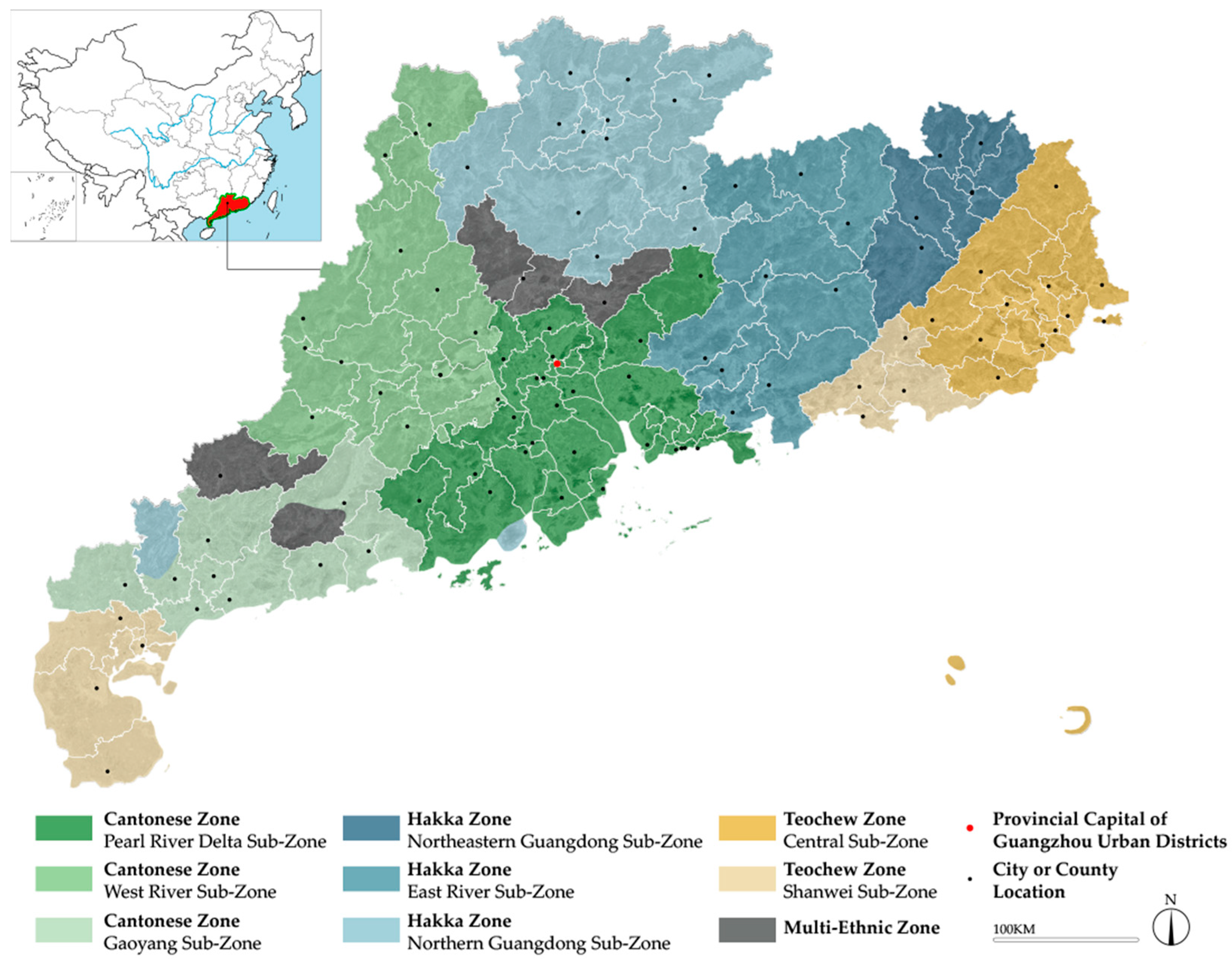


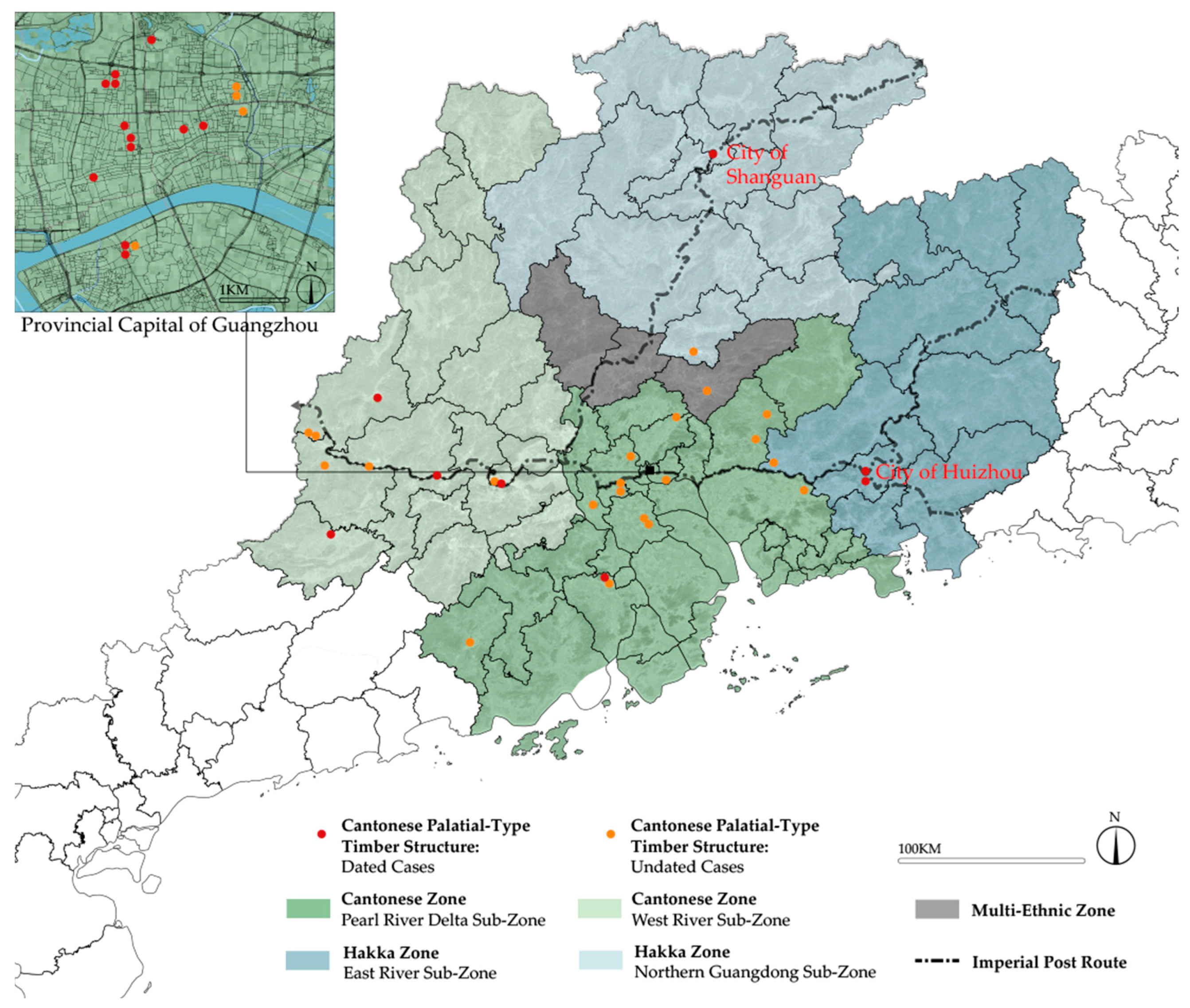
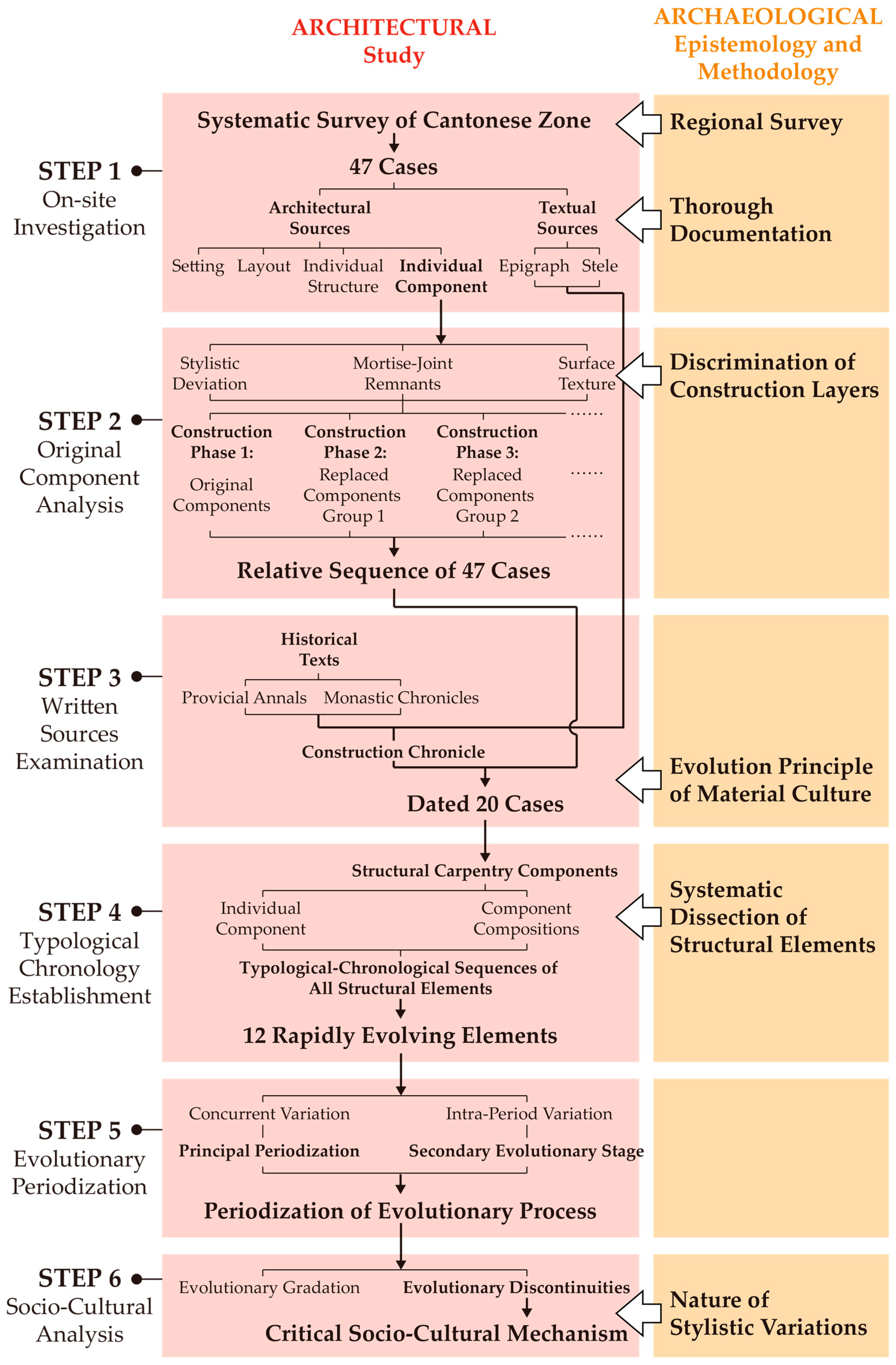

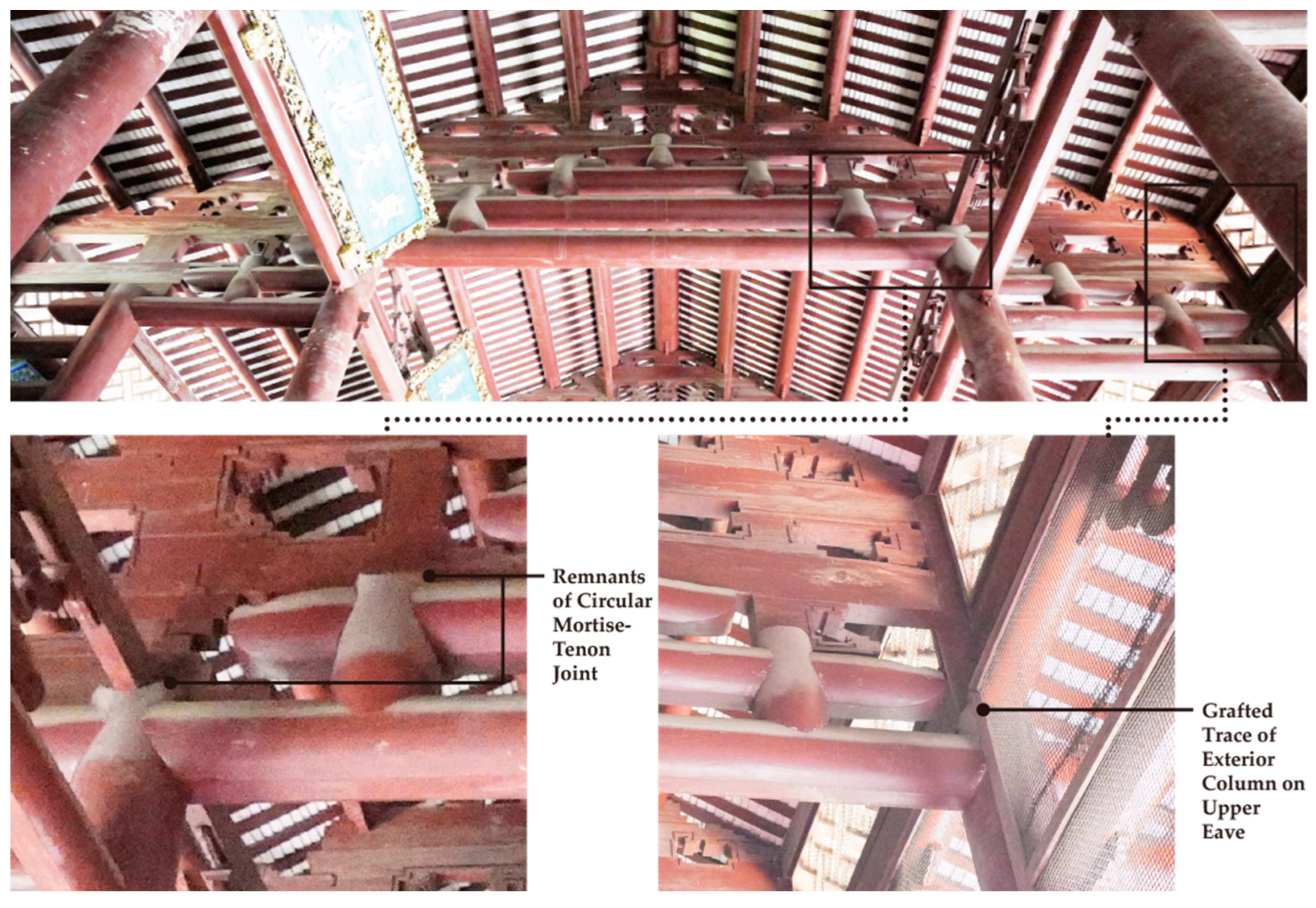
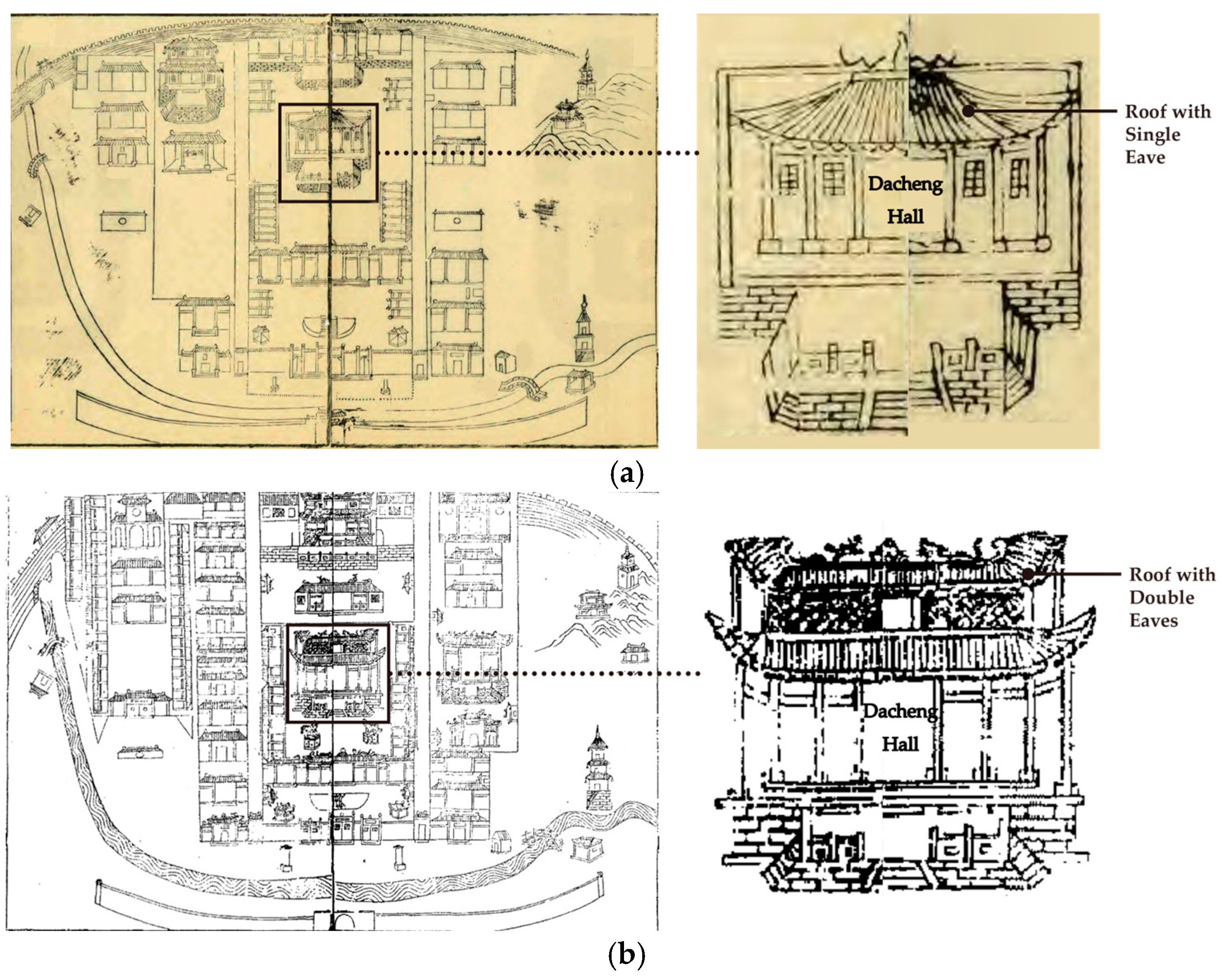

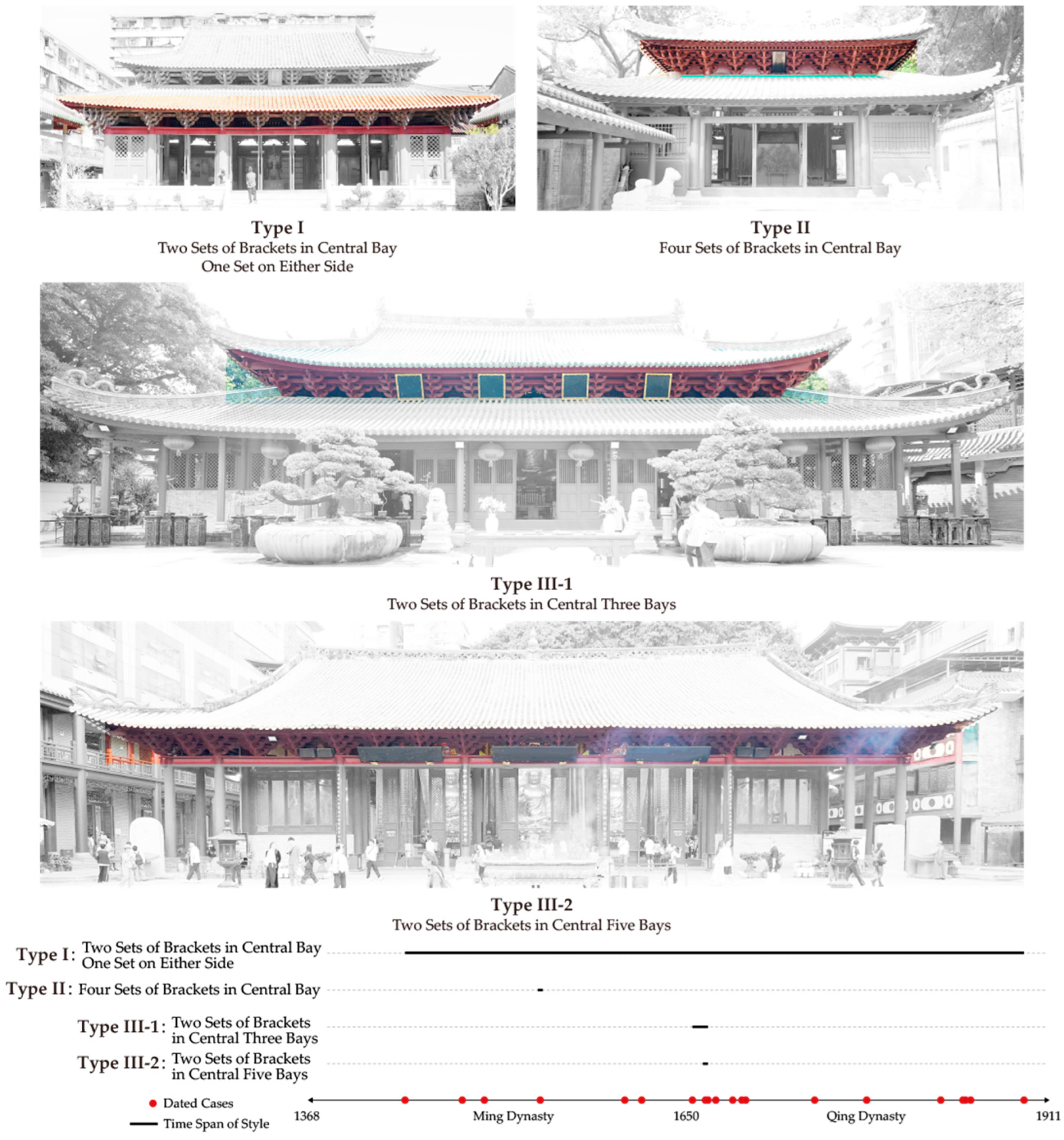
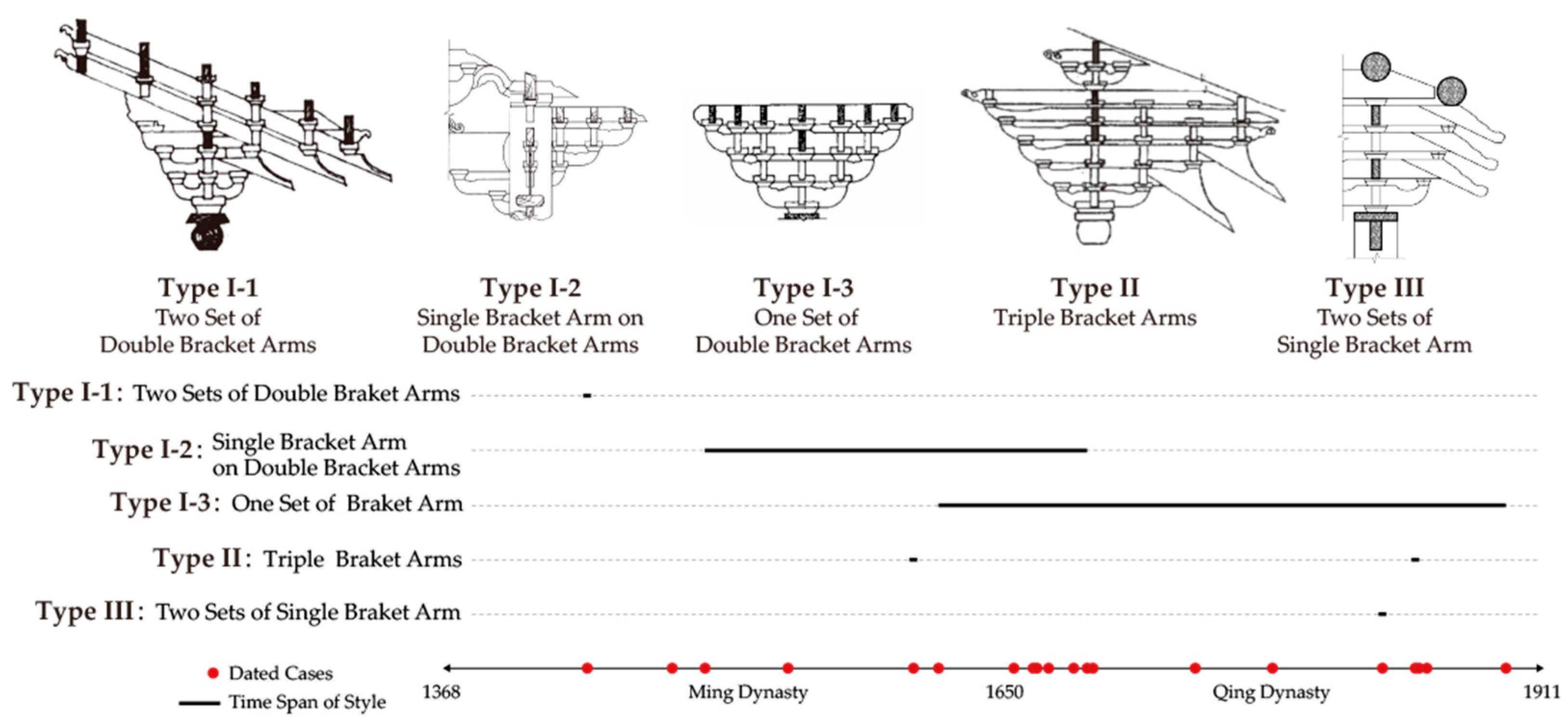
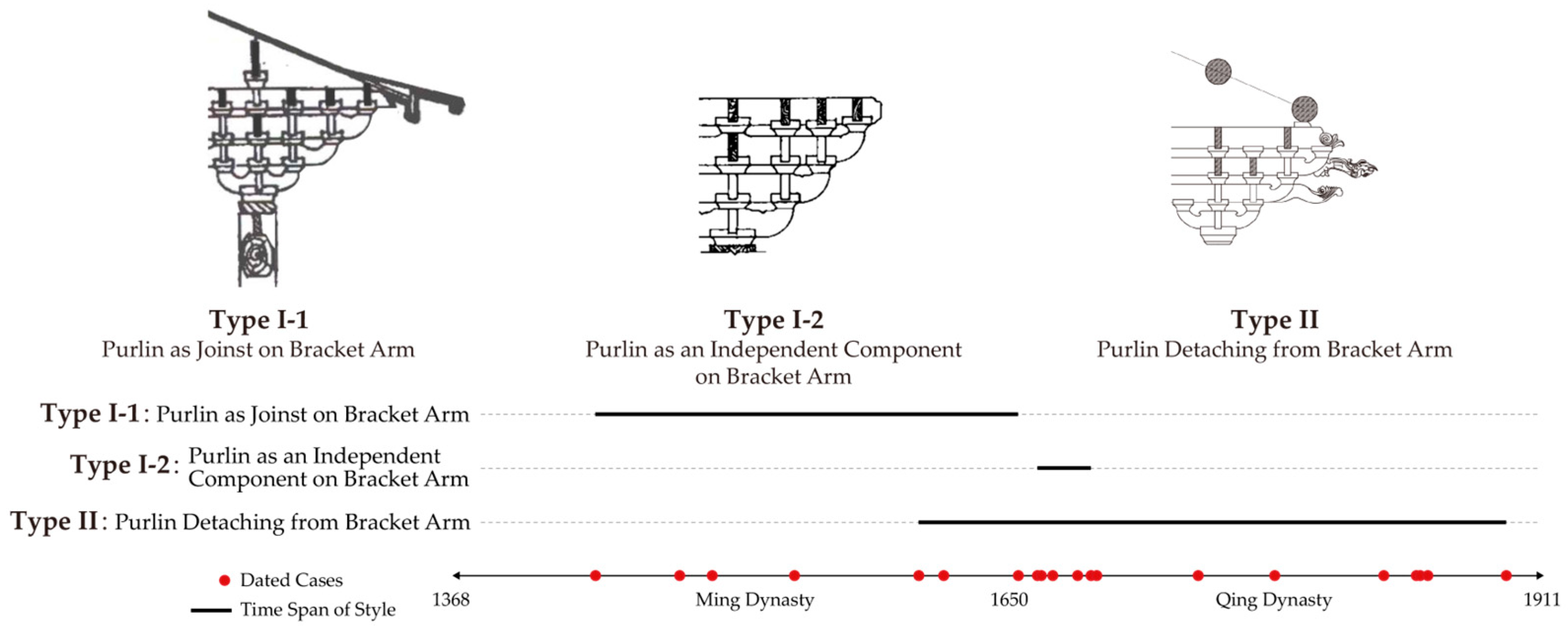


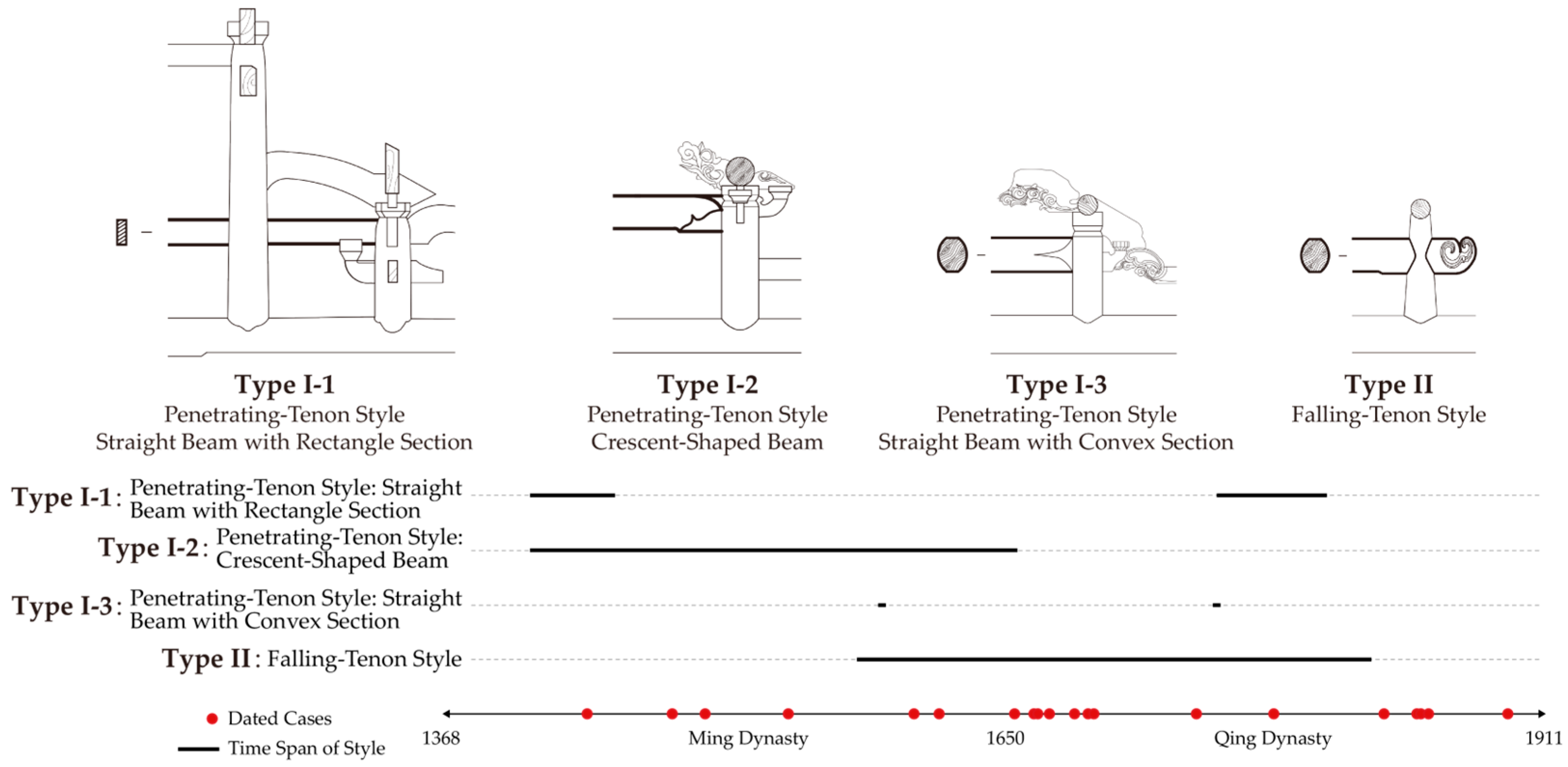

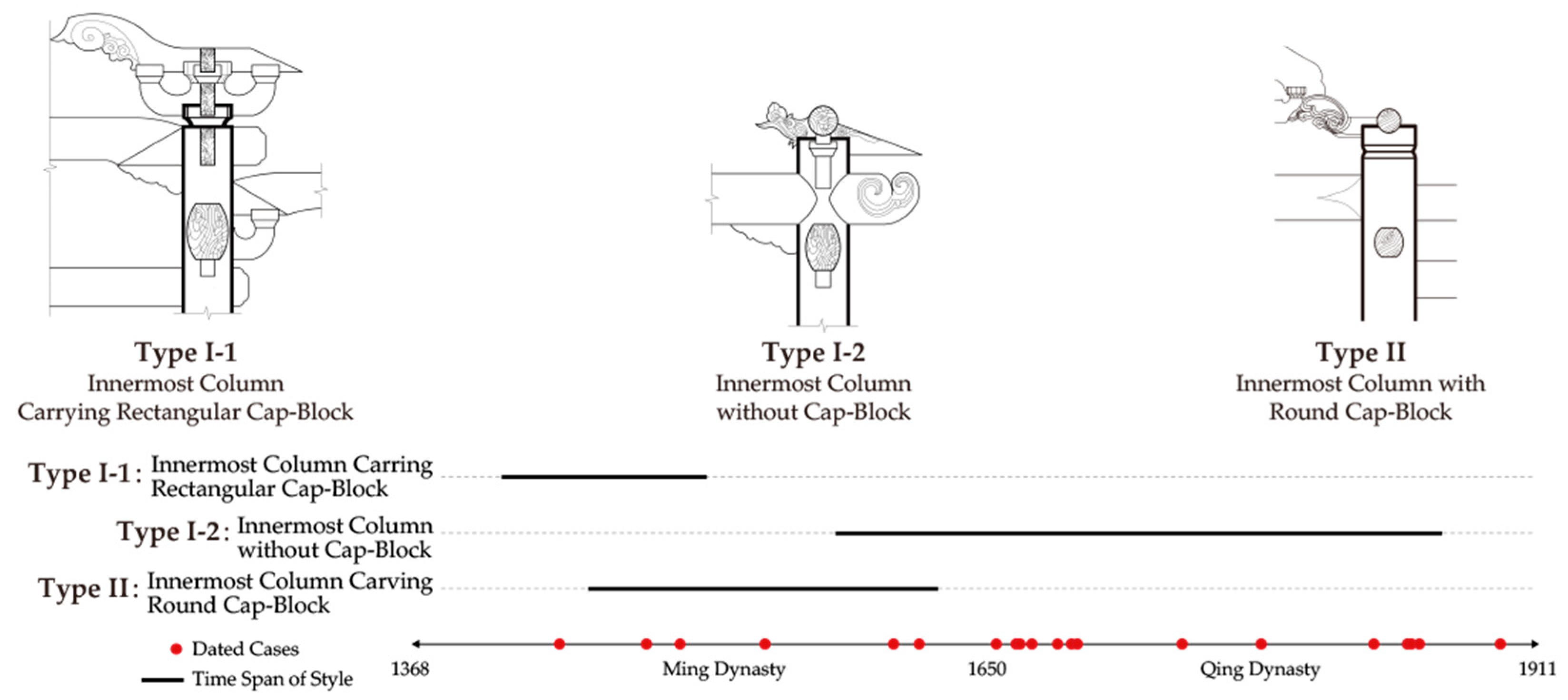
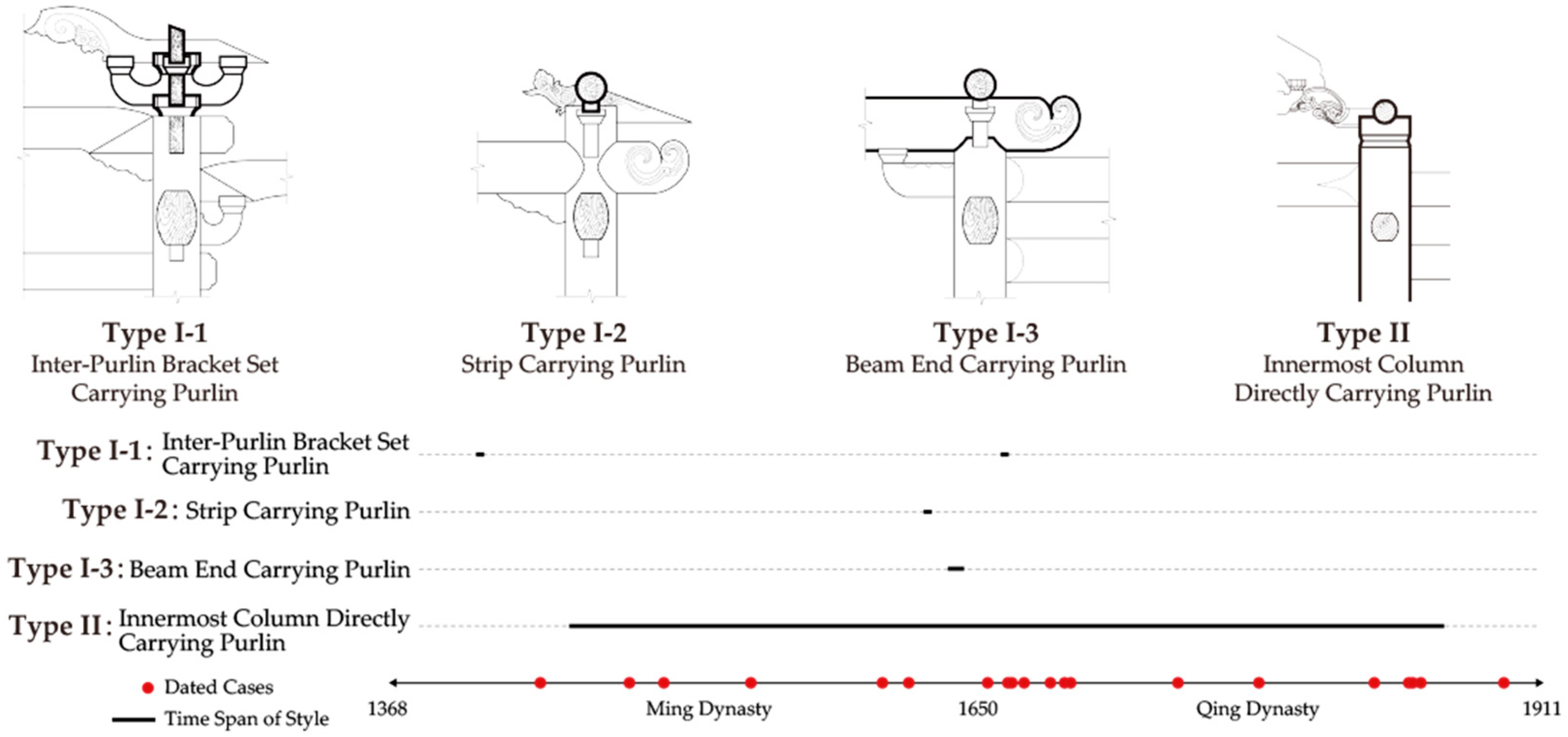
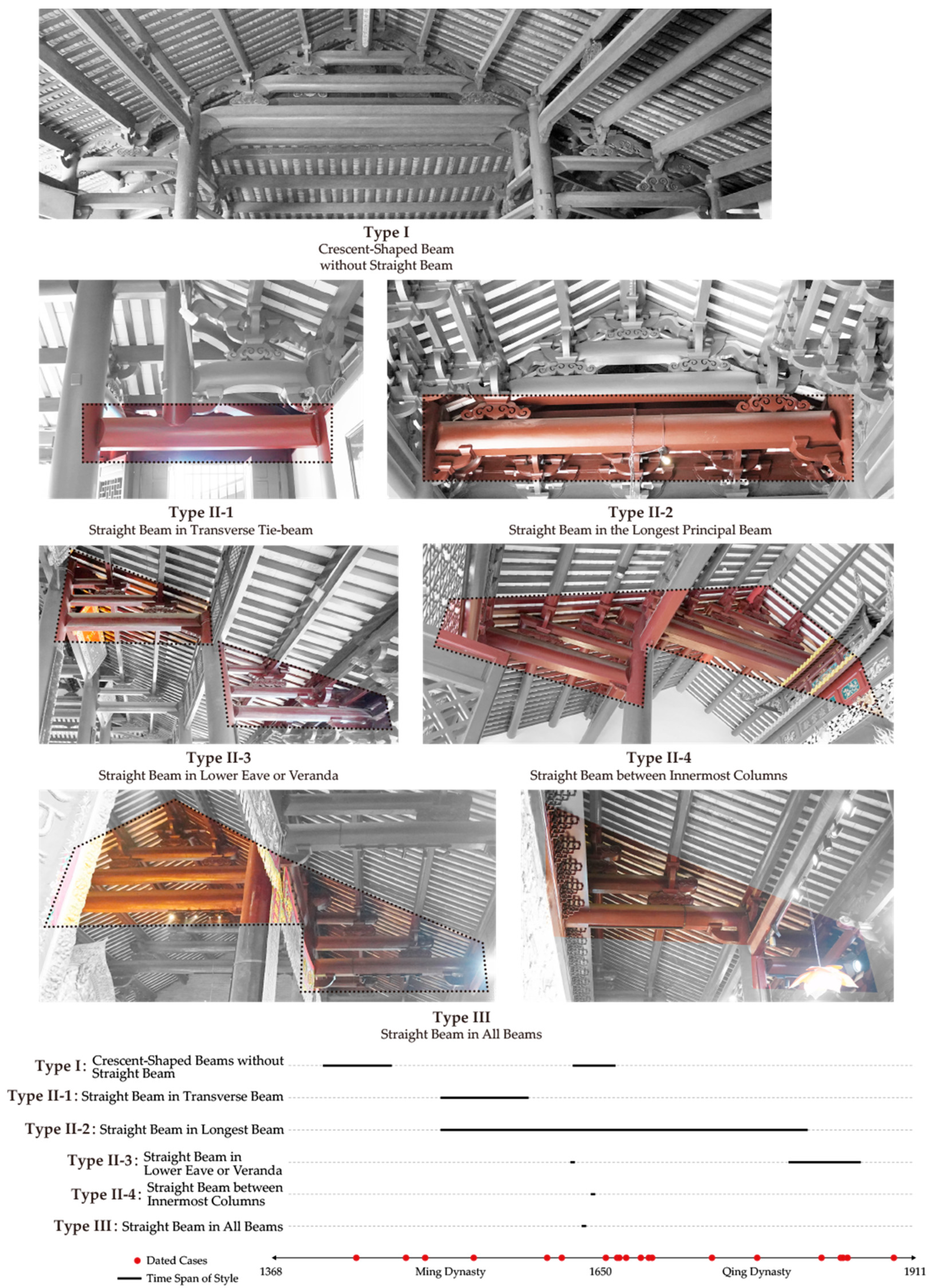
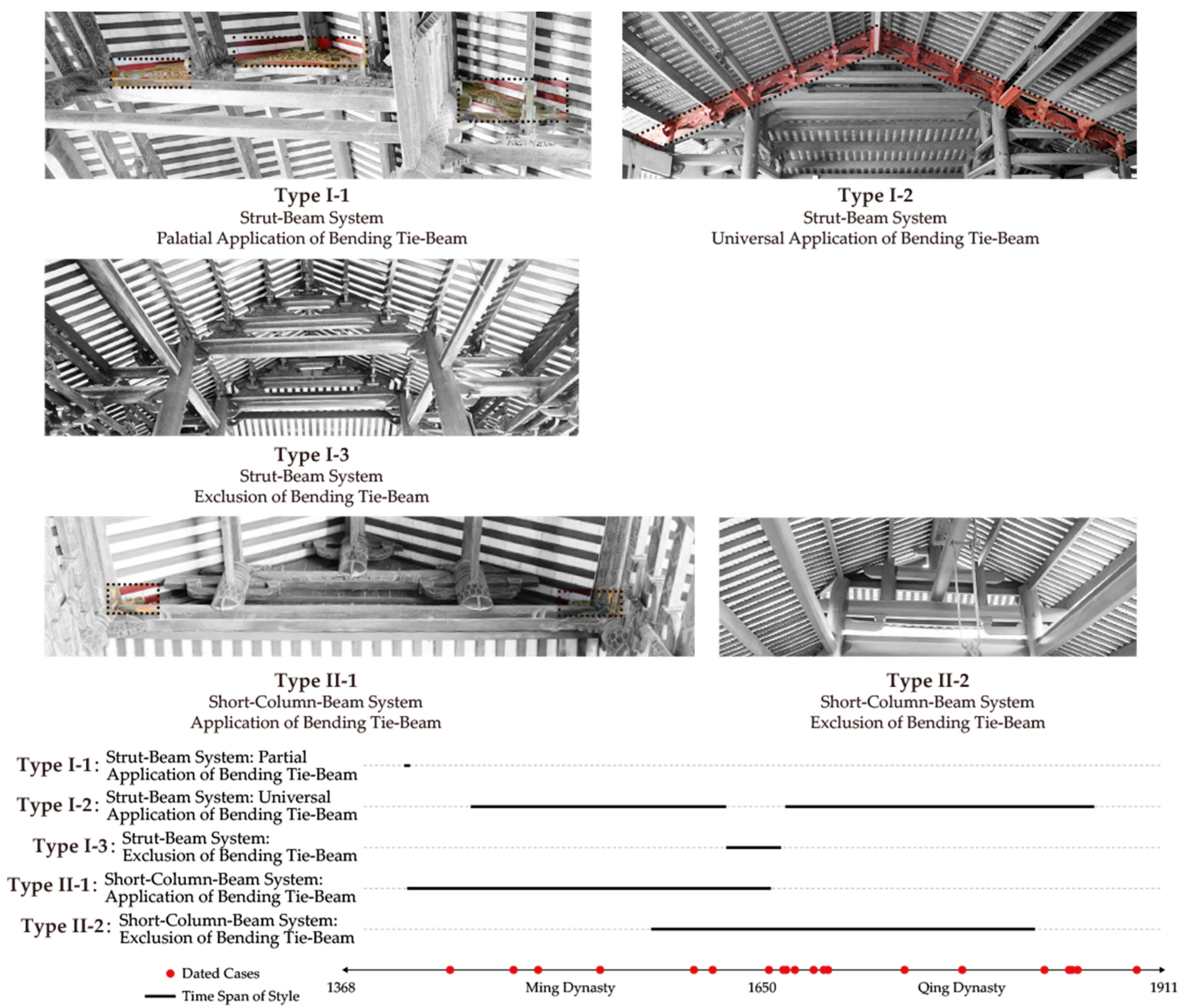

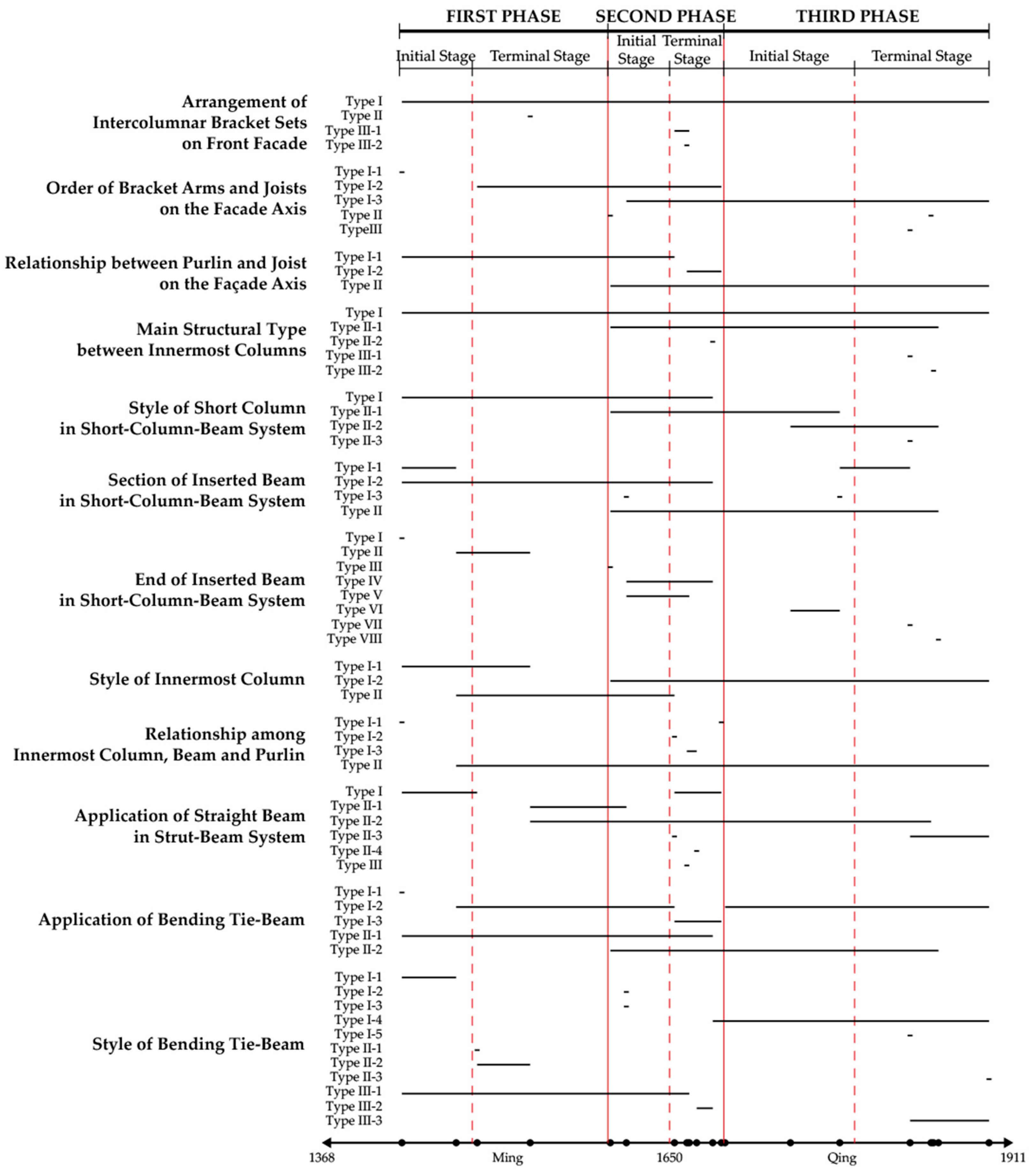



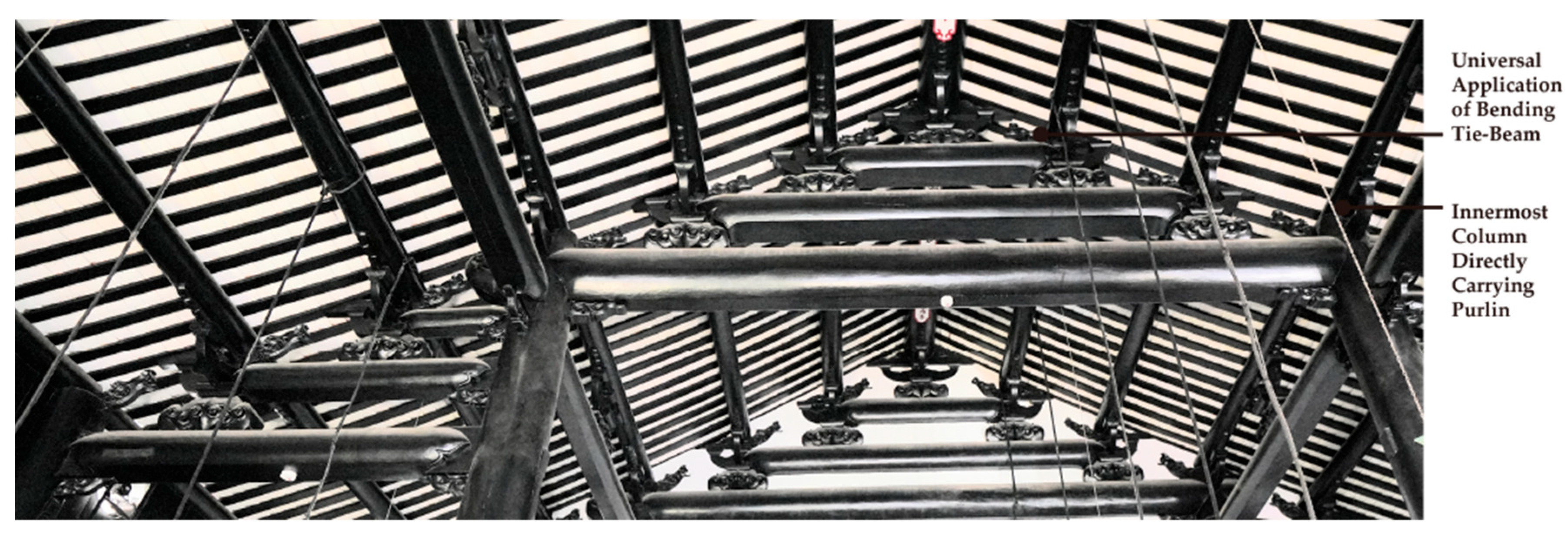

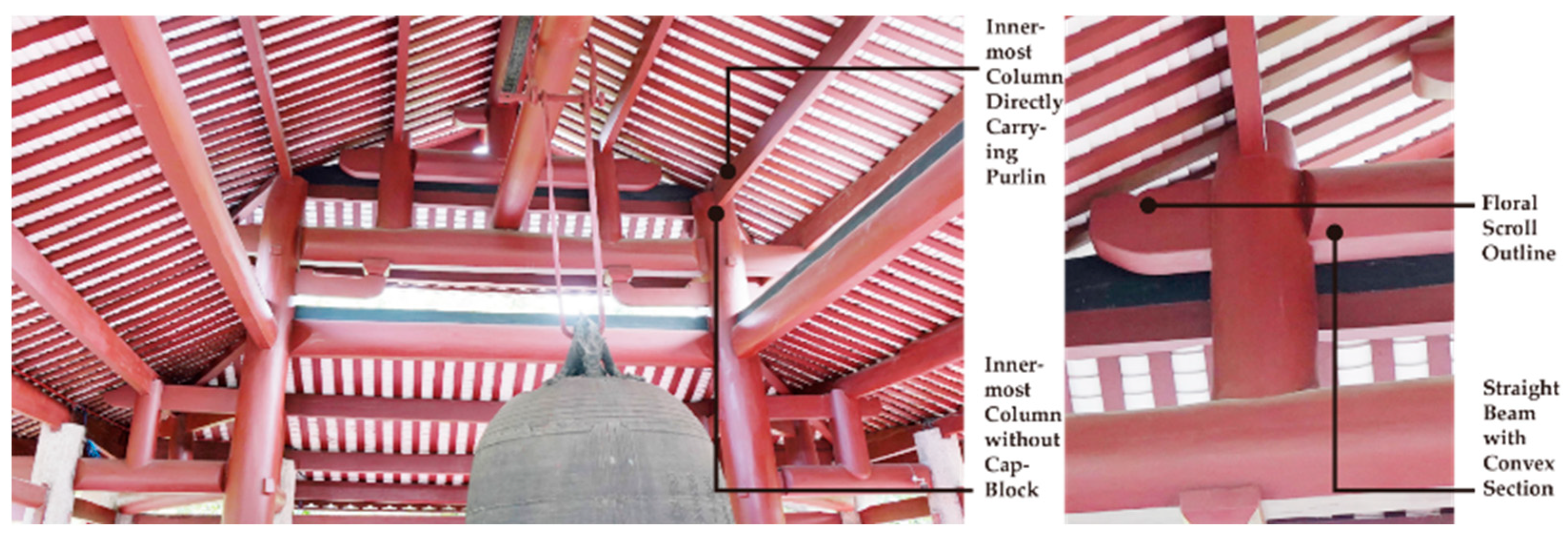

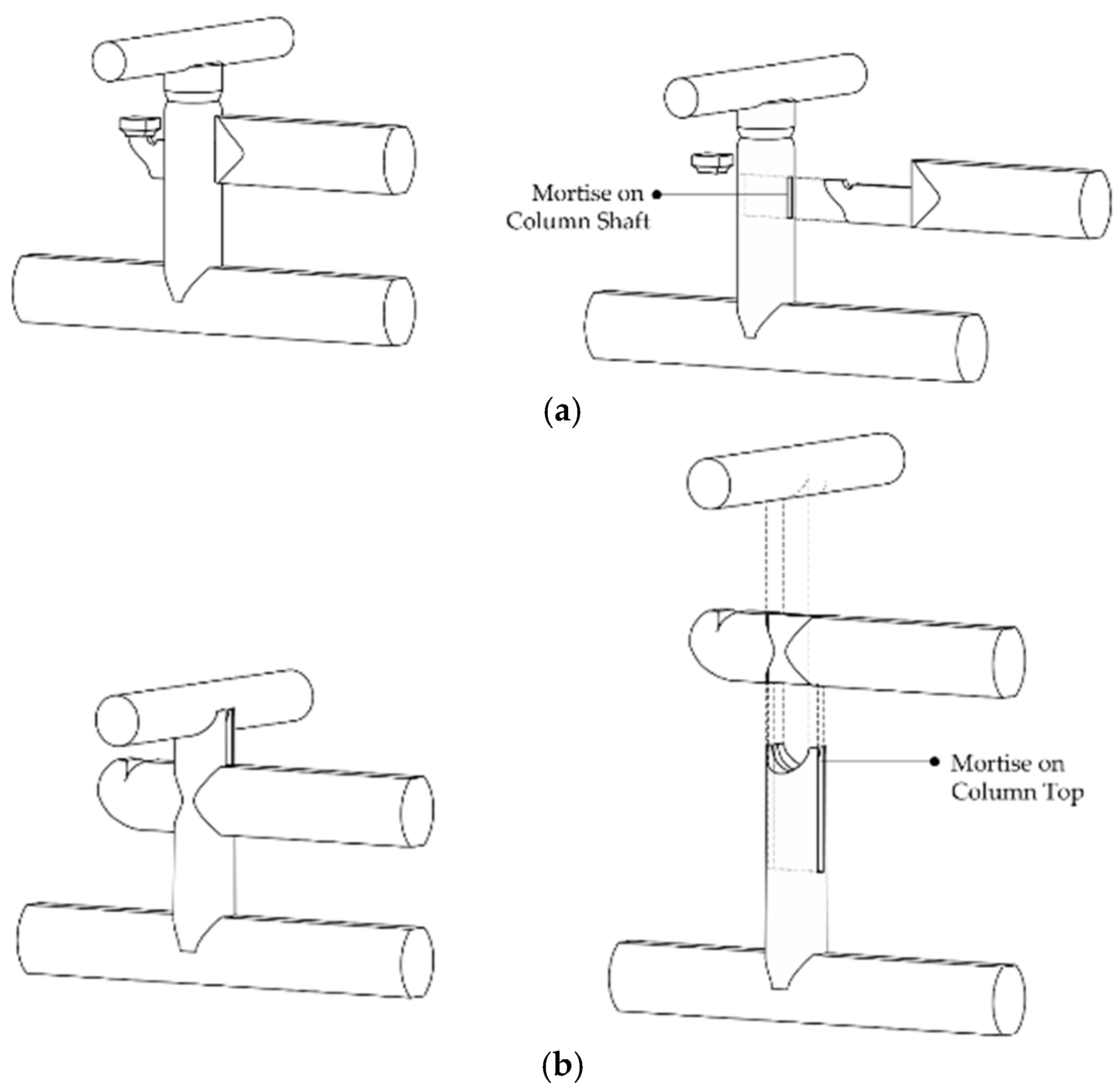
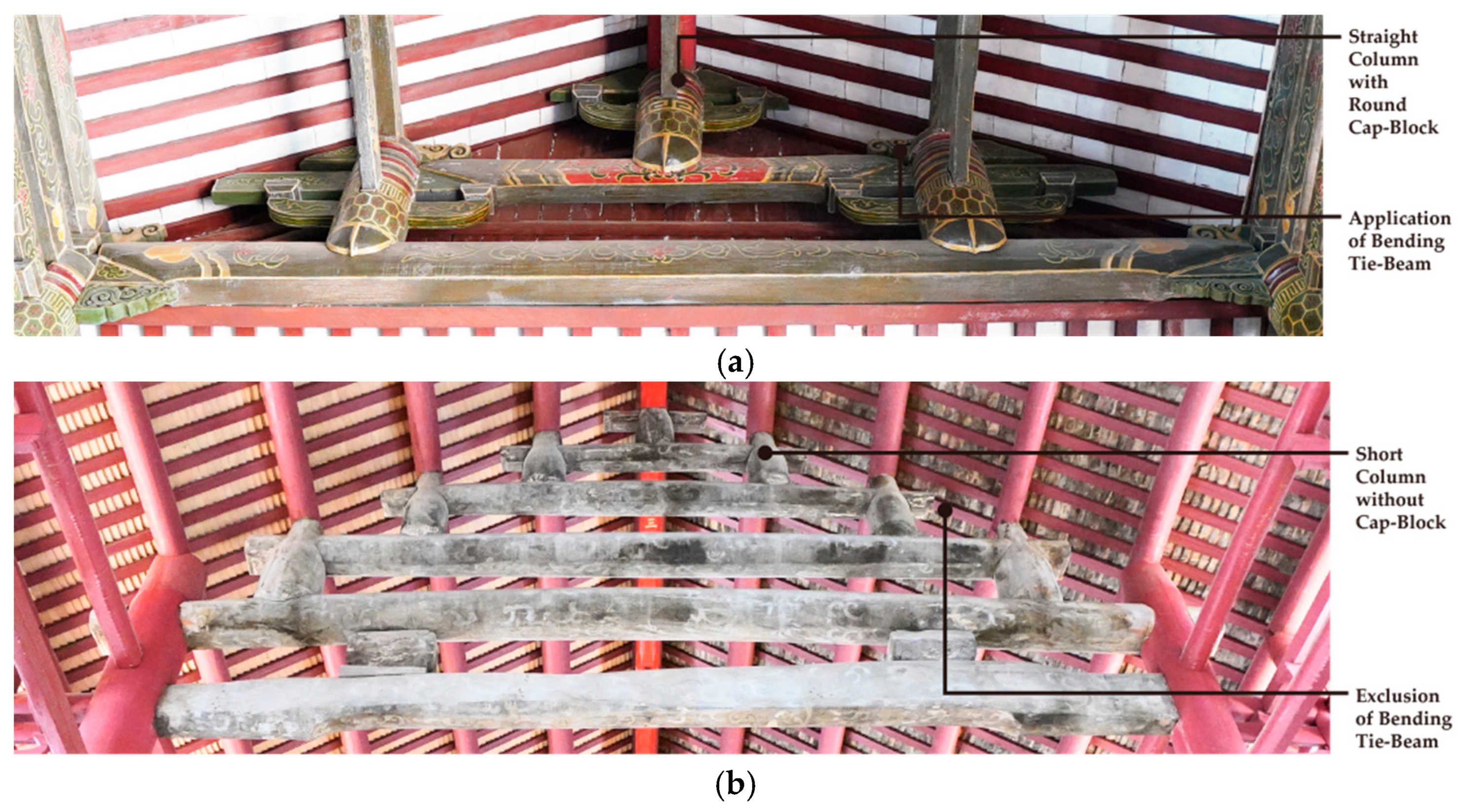
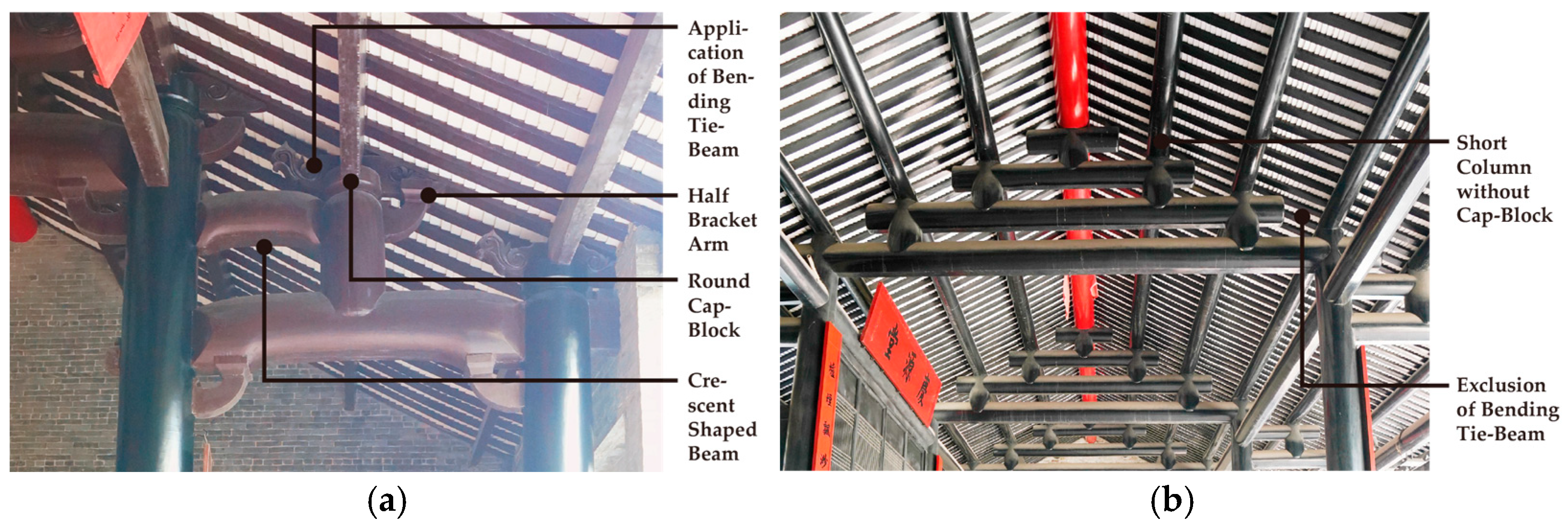



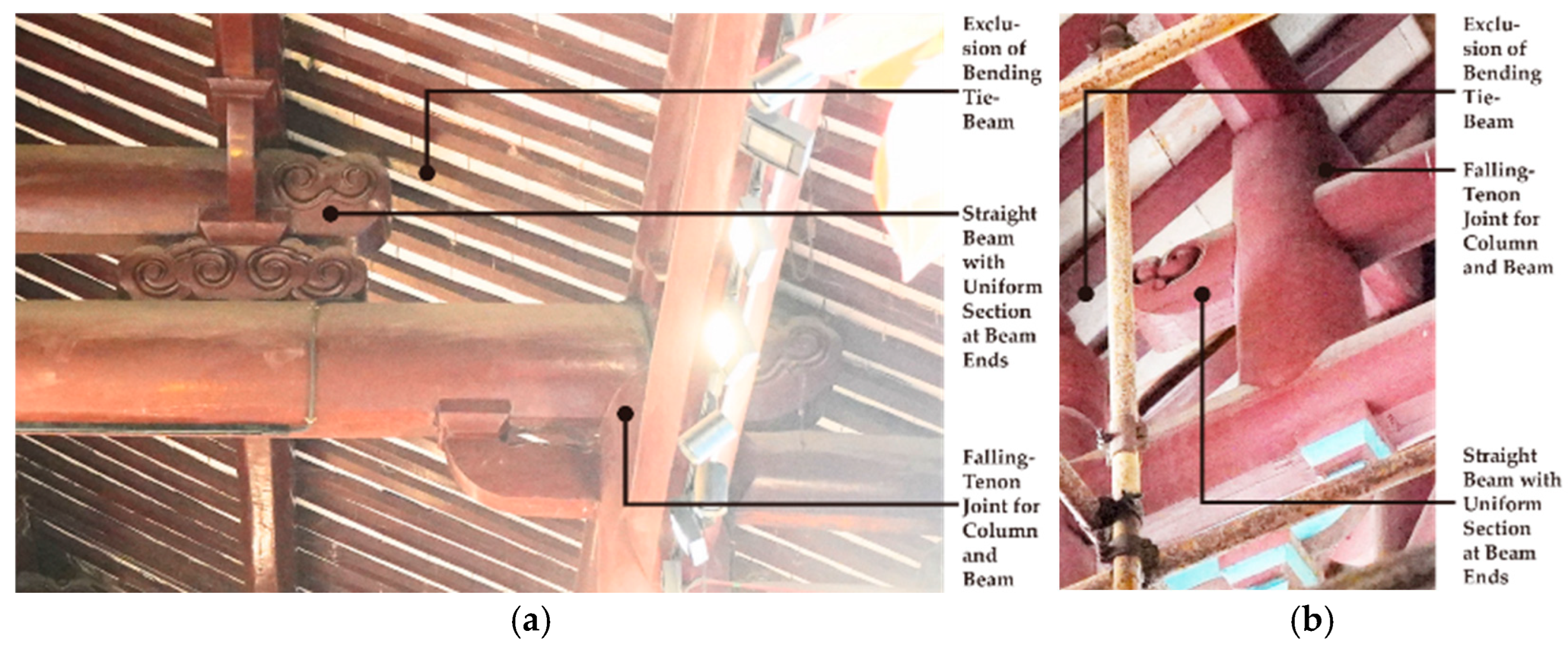
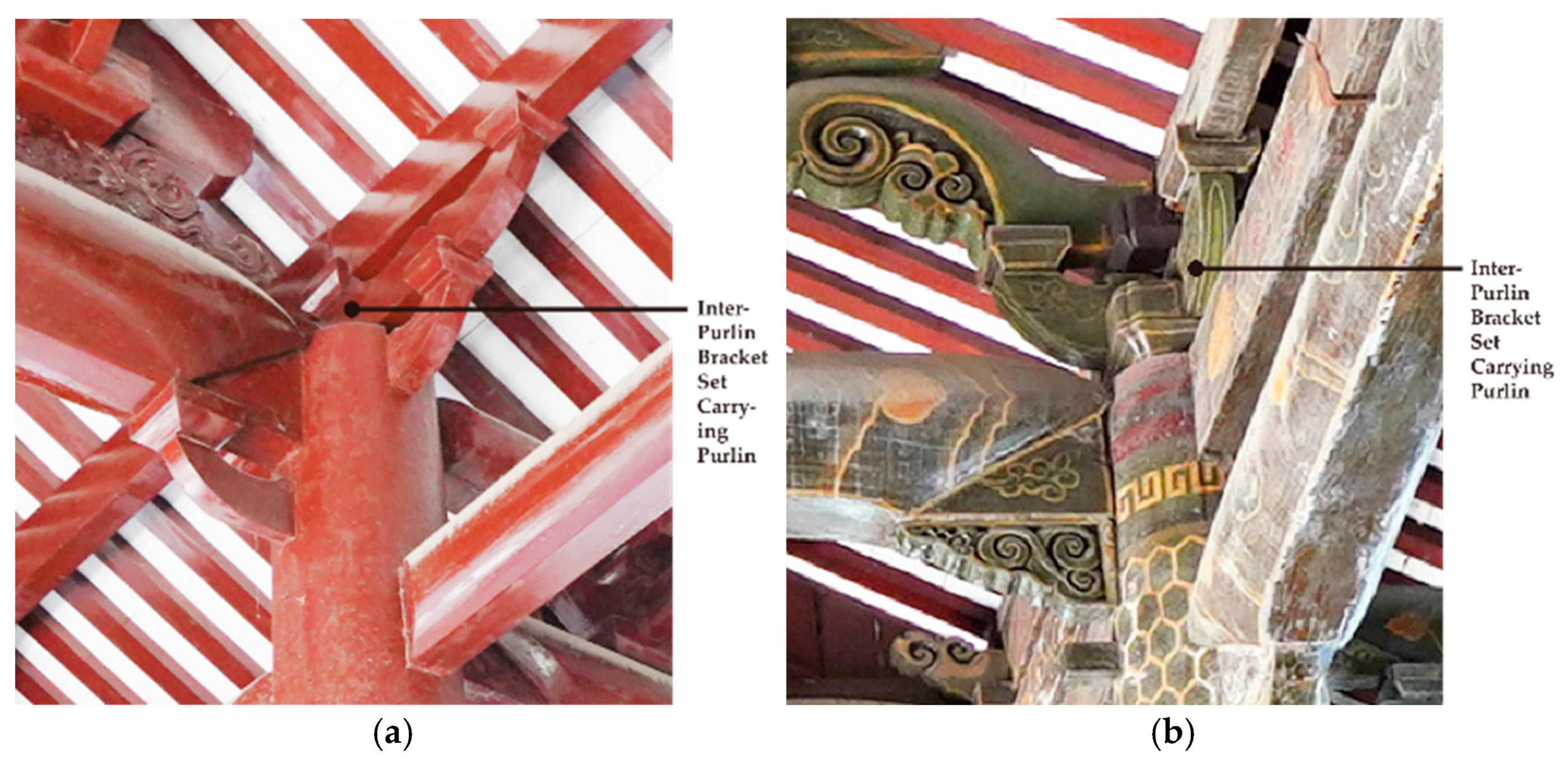
| Dynasty | No. | Name | Construction Date | Location | Roof | Plan | Bracket Set Type | Main Structure Type |
|---|---|---|---|---|---|---|---|---|
| Ming | 1 | Dacheng Hall, Confucian Temple of Zhaoqing | Xuande 6–8 [52] (1431–1433) | Duanzhou District, Zhaoqing | Hip-Gable, Single-Story with Double-Eave | Five-Bay in Width, Five-Bay in Depth | official-style (Both Eaves) | strut–beam |
| 2 | Main Hall, Daliang Temple | Chenghua 13 1 (1477) | Fengkai County, Zhaoqing | Hip-Gable, Single-Story with Single-Eave | Three-Bay in Width, Four-Bay in Depth | inserted half-bracket | strut–beam | |
| 3 | Qielan Hall, Guangxiao Temple | Hongzhi 7 2 (1494) | Yuexiu District, Guangzhou | Hip-Gable, Single-Story with Single-Eave | Three-Bay in Width, Three-Bay in Depth | official-style | strut–beam | |
| 4 | Rear Hall, Wuxian Temple | Jiajing 16 3 (1537) | Yuexiu District, Guangzhou | Hip-Gable, Single-Story with Double-Eave | Three-Bay in Width, Three-Bay in Depth | inserted half-bracket (Lower Eave) official-style (Upper Eave) | strut–beam | |
| 5 | Dacheng Hall, Confucian Temple of Shaoguan | Wanli 30 [53] (1602) | Zhenjiang District, Shaoguan | Hip-Gable, Single-Story with Double-Eave | Five-Bay in Width, Three-Bay in Depth | official-style (Both Eaves) | short-column-beam | |
| 6 | Dacheng Hall, Confucian Temple of Guishan | Wanli 41–43 [54] (1613–1615) | Huicheng District, Huizhou | Hip-Gable, Single-Story with Double-Eave | Five-Bay in Width, Five-Bay in Depth | official-style (Both Eaves) | short-column-beam | |
| Qing | 7 | Mahavira Hall, Guangxiao Temple | Shunzhi 6–11 [55] (1649–1654) | Yuexiu District, Guangzhou | Hip-Gable, Single-Story with Double-Eave | Seven-Bay in Width, Six-Bay in Depth | official-style (Lower Eave) inserted half-bracket (Upper Eave) | strut–beam |
| 8 | Main Hall, Haopan Mosque | Shunzhi 11 [56] (1654) | Yuexiu District, Guangzhou | Hip-Gable, Single-Story with Double-Eave | Five-Bay in Width, Five-Bay in Depth | inserted half-bracket (Both Eaves) | strut–beam | |
| 9 | Main Hall, Big Buddha Temple | Kangxi 2–3 [56] (1663–1664) | Yuexiu District, Guangzhou | Hip-Gable, Single-Story with Single-Eave | Seven-Bay in Width, Five-Bay in Depth | official-style | strut–beam | |
| 10 | Main Hall, Haichuang Temple | Kangxi 5 [56] (1666) | Haizhu District, Guangzhou | Hip-Gable, Single-Story with Double-Eave | Seven-Bay in Width, Five-Bay in Depth | inserted half-bracket (Lower Eave) official-style (Upper Eave) | short-column-beam | |
| 11 | Devaraja Hall, Haichuang Temple 4 | Kangxi 11 [57] (1672) | Haizhu District, Guangzhou | Hip-Gable, Single-Story with Single-Eave | Five-Bay in Width, Five-Bay in Depth | inserted half-bracket | strut–beam | |
| 12 | Gate Hall, Confucian Temple of Guishan | Kangxi 20–24 [54] (1681–1685) | Huicheng District, Huizhou | Flush-gable 5, Single-Story with Single-Eave | Five-Bay in Width, Two-Bay in Depth | official-style (Front Eave) inserted half-bracket (Back Eave) | strut–beam with short-column-beam | |
| 13 | Sixth Patriarch Hall, Guangxiao Temple | Kangxi 31 [56] (1692) | Yuexiu District, Guangzhou | Hip-Gable, Single-Story with Single-Eave | Five-Bay in Width, Four-Bay in Depth | official-style | strut–beam | |
| 14 | Kanyue Hall, Huaisheng Mosque | Kangxi 34 [56] (1695) | Yuexiu District, Guangzhou | Hip-Gable, Single-Story with Double-Eave | One-Bay in Width, One-Bay in Depth | official-style (Both Eaves) | strut–beam | |
| 15 | Short-Column-Beam System of Upper Eave of Dacheng Hall 6, Confucian Temple of Xinhui | Qianlong 13 (1748) | Jiangmen City, Xinhui | Hip-Gable, Single-Story with Single-Eave | Five-Bay in Width | — | short-column-beam | |
| 16 | Bell Tower, Wuxian Temple | Qianlong 53 7 (1788) | Yuexiu District, Guangzhou | Hip-Gable, Single-Story with Double-Eave | Three-Bay in Width, Three -Bay in Depth | inserted half-bracket (Both Eaves) | short-column-beam | |
| 17 | Dacheng Hall, Confucian Temple of Luoding | Daoguang 21–25 [58] (1841–1845) | Luoding City, Yunfu | Hip-Gable, Single-Story with Double-Eave | Five-Bay in Width, Five-Bay in Depth | official-style (Both Eaves) | strut–beam with shelf-shaped beam system | |
| 18 | Dacheng Hall 8, Confucian Temple of Guangzhou | Tongzhi 1 [59] (1862) | Yuexiu District, Guangzhou | Hip-Gable, Single-Story with Single-Eave | Five-Bay in Width, Three -Bay in Depth | official-style | strut–beam | |
| 19 | Shelf-Shaped Beam System of Upper Eave and Structure of Lower Eave of Dacheng Hall, Confucian Temple of Xinhui | Xianfeng 11-Tongzhi 3 (1861–1864) | Jiangmen City, Xinhui | Hip-Gable, Single-Story with Double-Eave | Seven-Bay in Width, Five-Bay in Depth | official-style (Lower Eave) inserted half-bracket (Upper Eave) | shelf-shaped beam system | |
| 20 | Sanyuan Hall, Suanyuan Temple | Tongzhi 7 [60] (1868) | Yuexiu District, Guangzhou | Hip-Gable, Single-Story with Single-Eave | Five-Bay in Width, Five -Bay in Depth | inserted half-bracket | short-column-beam | |
| 21 | Main Hall, Longmu Temple of Yuecheng | Guangxu 31 9 (1905) | Deqing County, Zhaoqing | Hip-Gable, Single-Story with Double-Eave | Five-Bay in Width, Five -Bay in Depth | inserted half-bracket (Both Eaves) | strut–beam |
Disclaimer/Publisher’s Note: The statements, opinions and data contained in all publications are solely those of the individual author(s) and contributor(s) and not of MDPI and/or the editor(s). MDPI and/or the editor(s) disclaim responsibility for any injury to people or property resulting from any ideas, methods, instructions or products referred to in the content. |
© 2025 by the author. Licensee MDPI, Basel, Switzerland. This article is an open access article distributed under the terms and conditions of the Creative Commons Attribution (CC BY) license (https://creativecommons.org/licenses/by/4.0/).
Share and Cite
Ren, Y. Study on the Typological Chronology of Cantonese Palatial-Type (Diantang Shi) Timber Structures in Guangdong Province, China: An Interdisciplinary Approach of Building Archaeology. Buildings 2025, 15, 2447. https://doi.org/10.3390/buildings15142447
Ren Y. Study on the Typological Chronology of Cantonese Palatial-Type (Diantang Shi) Timber Structures in Guangdong Province, China: An Interdisciplinary Approach of Building Archaeology. Buildings. 2025; 15(14):2447. https://doi.org/10.3390/buildings15142447
Chicago/Turabian StyleRen, Yunan. 2025. "Study on the Typological Chronology of Cantonese Palatial-Type (Diantang Shi) Timber Structures in Guangdong Province, China: An Interdisciplinary Approach of Building Archaeology" Buildings 15, no. 14: 2447. https://doi.org/10.3390/buildings15142447
APA StyleRen, Y. (2025). Study on the Typological Chronology of Cantonese Palatial-Type (Diantang Shi) Timber Structures in Guangdong Province, China: An Interdisciplinary Approach of Building Archaeology. Buildings, 15(14), 2447. https://doi.org/10.3390/buildings15142447





